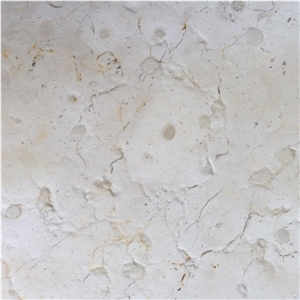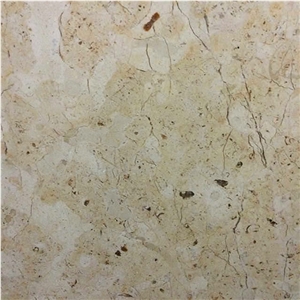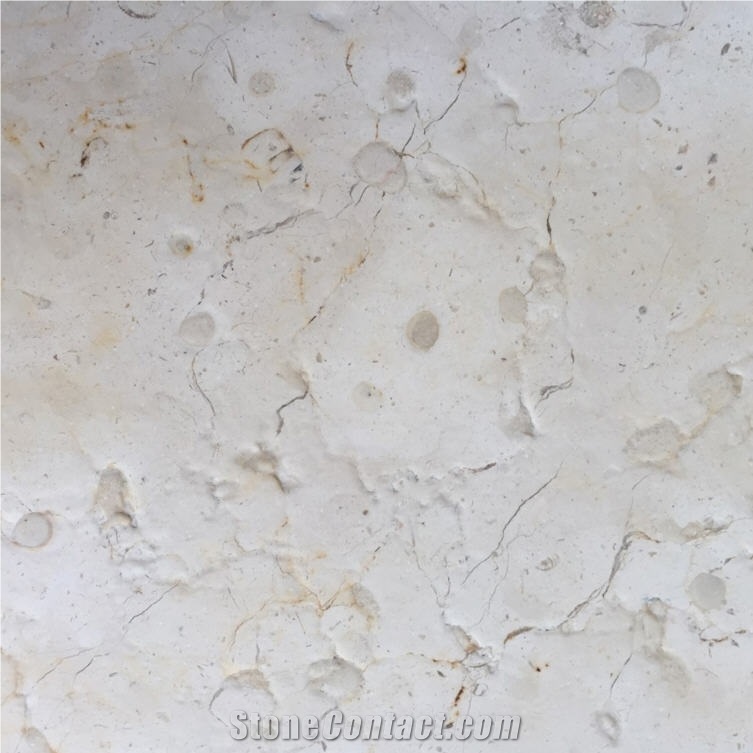Beit Fajjar Limestone
 Palestine
(Beit Fajjar, Bethlehem, central West Bank)
Palestine
(Beit Fajjar, Bethlehem, central West Bank)
Beit Fajjar Limestone, known for its warm bone‑white base with creamy golden‑beige shades, light golden beige veins, and scattered shelly fossil patterns. Quarried in the Beit Fajjar area near Bethlehem in the central West Bank’s Jerusalem/Holy Land region, this stone is prized for both its aesthetic and technical qualities.
Appearance, Texture & Pattern
Color Palette: Warm bone white to light creamy golden beige base with soft light golden beige veins. The stone is enriched with shelly fossil segments, providing a naturally decorative sedimentary look.
Texture: Fine to medium crystalline grain, with a smooth yet tactile surface, characteristic of well-formed limestone.
Pattern: Subtle, irregular fossil scatter along with occasional linear veining; visually consistent but inherently organic.
Hardness & Composition Hardness:
Approximately 3–4 on the Mohs scale, typical of calcitic limestone.
Mineral Makeup:
- CaCO₃ (Calcite): ~95–98% by weight
- Minor components include MgCO₃ (<1%), SiO₂ (silica), Fe₂O₃ and Al₂O₃ in trace amounts
- These contribute to its polished cream tone and mild fossil coloration.
Usage & Applications
Beit Fajjar Limestone is highly popular in the region for both interior and exterior applications:
Exterior facade cladding (thanks to low water absorption and weather resistance)
Interior wall & floor tiles
Countertops and vanities
Monuments, fountains, and landscape stone elements
Mosaics and decorative features
Its moderate hardness and elegant patterns make it ideal for prestigious residential and commercial architecture, especially in Mediterranean or Middle Eastern climates
Cut Sizes & Surface Finishes
Standard tile formats: 30×30 cm, 60×30 cm, 60×60 cm, 80×40 cm, etc.
Slab thicknesses: Typically 2 cm and 3 cm, and custom sizes up to large panels on request.
Finish options include:
- Polished
- Honed
- Sawn Cut
- Sanded
- Rock‑faced
- Sandblasted
- Bush‑hammered
- Tumbled
These textures offer options for both smooth elegance and rough, tactile facades stonecontact.com.
Maintenance & Durability
Sealing is advised, especially for wet areas or exterior use, to guard against staining and moisture absorption.
Cleaning: Use pH-neutral stone cleaners; avoid acidic agents like vinegar or citrus.
Durability: Suitable for hot, dry Mediterranean climates. In high-rainfall areas, a high-quality sealant is recommended to mitigate risks of water penetration and salt efflorescence stonecontact.com.
Summary Table
- Origin: Beit Fajjar area, Bethlehem, West Bank, Palestine
- Color/Veining: Bone white with creamy golden beige shades and veins
- Texture: Fine to medium-grained limestone
- Water Absorption: ~0.9–1.0%
- Density: ~2,600–2,620 kg/m³
- Compressive Strength: ~76–126 MPa (dry), ~59–87 MPa (wet)
- Flexural Strength: ~6.8–7.2 MPa
- Hardness: ~3–4 (Mohs)
- Main Mineral: Calcite (CaCO₃) ~95–98%
- Applications: Exterior/interior cladding, flooring, monuments
- Finish Options: Polished, honed, rock-faced, sandblasted, etc.
- Maintenance: Seal and clean with pH-neutral care
-

-

-

 Palestine
Palestine
 Verified Supplier is for prove company authenticity,including business license,trade license and effective office space,to enhance buyers' trust to suppliers and their products, reducing communication costs.
Verified Supplier is for prove company authenticity,including business license,trade license and effective office space,to enhance buyers' trust to suppliers and their products, reducing communication costs.
Contact Supplier
-

Sharabati Modern Co. for Marble and Stones
 Palestine
Palestine
 Verified Supplier is for prove company authenticity,including business license,trade license and effective office space,to enhance buyers' trust to suppliers and their products, reducing communication costs.
Verified Supplier is for prove company authenticity,including business license,trade license and effective office space,to enhance buyers' trust to suppliers and their products, reducing communication costs.
Contact Supplier
-

The request includes: 1. surface finished, size 2. quantity required










 Jordan
Jordan United Arab Emirates
United Arab Emirates